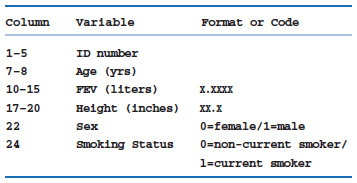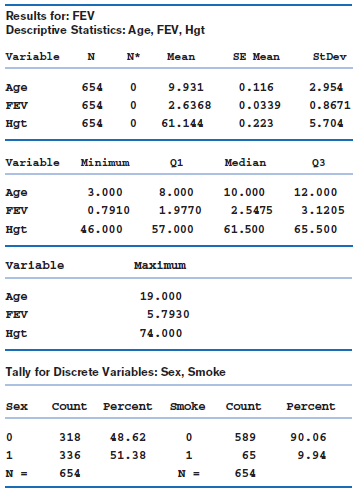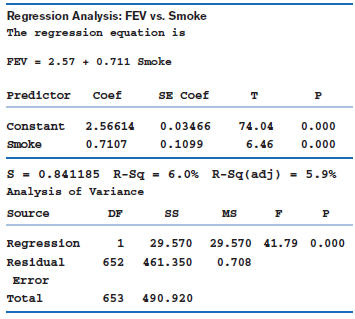The regression coefficient for smoking is 0.7 ± 0.1, p < .001. Does this mean that smokers
Question:
Table 11.31: FEV.DOC

Some descriptive statistics of the variables in the data set using Minitab are given in Table 11.32.
Table 11.32: Descriptive statistics for FEV.DAT

We first ran a regression of FEV on smoking as shown in Table 11.13.
Table 11.33: Regression of FEV on smoking in FEV.DAT

Transcribed Image Text:
Format or Code Column Variable ID number 1-5 7-8 Age (yrs) FEV (1iters) 10-15 х.ххх 17-20 Height (inches) хх.х 22 0=female/1=male Sex 24 Smoking status 0=non-current smoker/ 1=current Smoker Results for: FEV Descriptive Statistics: Age, FEV, Hgt Variable Mean SE Mean StDev Age 654 9.931 0.116 2.954 FEV 654 2.6368 0.0339 0.8671 Hgt 654 61.144 0.223 5.704 Variable Minimum Q1 Median Q3 Age 3.000 8.000 10.000 12.000 FEV 0.7910 1.9770 2.5475 3.1205 Hgt 46.000 57.000 61.500 65.500 Variable Maximum Age 19.000 FEV 5.7930 Hgt 74.000 Tally for Discrete Variables: Sex, Smoke Sex Count Percent Smoke Count Percent 48.62 58 90.0 336 51.38 65 9.94 654 654
Fantastic news! We've Found the answer you've been seeking!
Step by Step Answer:
Answer rating: 84% (13 reviews)
This means that the smokers in this data set had ...View the full answer

Answered By

Mugdha Sisodiya
My self Mugdha Sisodiya from Chhattisgarh India. I have completed my Bachelors degree in 2015 and My Master in Commerce degree in 2016. I am having expertise in Management, Cost and Finance Accounts. Further I have completed my Chartered Accountant and working as a Professional.
Since 2012 I am providing home tutions.
3.30+
2+ Reviews
10+ Question Solved
Related Book For 

Question Posted:
Students also viewed these Mathematics questions
-
Consider Table 12.5.15, showing the partial results from a multiple regression analysis that explains the annual sales of 25 grocery stores by some of their characteristics. The variable mall is 1 if...
-
A study was recently performed by the American Automobile Association in which it attempted to develop a regression model to explain variation in Environmental Protection Agency (EPA) mileage ratings...
-
The following is the quadratic regression equation for a sample of n = 25: a. Predict Y for b. Suppose that the computed tSTAT test statistic for the quadratic regression coefficient is 2.35. At the...
-
If net assets of a business totalled 200,000 and its total assets on that date amounted to 325,000, its liabilities would amount to: (a) 125,000 (b) 200,000 (c) 525,000 (d) Not sufficient information...
-
1. Because triangle A is congruent with triangle B, and triangle A is isosceles, it follows that triangle B is isosceles. 2. The plaque on the Leaning Tower of Pisa says that Galileo performed...
-
When Parental Times Ltd bought the shares of Siblings Ltd it valued the fixed assets at 120,000 instead of the figure of 90,000 as shown in the balance sheet of Siblings Ltd. Draw up a consolidated...
-
What are the four conditions needed for uninterrupted flow? Describe each. LO,1
-
Sketch vo for the network of Fig. 2.169 and determine the dc voltage available. 100 V Ideal diodes -100 V 2.2 k 2.2 k 2.2 k
-
OM Sum Check my wars CIA Review.inc provides review courses twice each year for students studying to take the CIA exam. The cost of textbooks included in the registration fee. Text material requires...
-
Which of the following MIPS(32-bit) instructions branches maximum distance? a) BEQ b) BGTZ c) JAL d) BLT
-
What does the regression coefficient for smoking mean in Table 11.34? How does it differ from the regression coefficient in Table 11.33? It is well known that age, height, and sex are important...
-
Provide a 95% Cl for the true correlation coefficient?
-
What would happen to the analysis done above if your competitor introduces a graphite composite that is even lighter than your product? What factors would this likely affect? Do an NPV analysis...
-
Complete Exercises 2-B and 2-H in Writing and Analysis in the Law using what you learned in the reading and in the Seminar. Use paragraph form, use complete sentences, and make sure you use proper...
-
What is the value of a stock expected to be in 9 years if the annual dividend is expected to remain unchanged forever at $3.65, the expected rate of return is 6.9% per year, and the next dividend is...
-
Once invested IN a corporation, shareholders want their money out - they want a return on investment! John owns 2 5 % of REFUND CORP INC, which paid out a $ 5 0 , 0 0 0 distribution to him on 1 2 / 3...
-
Worksheet Financial Statement Ratios. Lowe's Companies, Inc Jan 28, 2022 and Jan. 29, 2021 Current Ratio Current Assets / Current Liabilities Acid Test Current Assets Current Liabilities (Cash + ST...
-
3. Peter Senen operates in a JIT manufacturing system. For August, Peter Senen purchased 10,000 units of raw materials at P1.00 per unit on account.What is the The journal entry to record the...
-
Let a function f be the line graph connecting the data points (1, 2), (4,9), and (6,3). (a) Write the formula for a piecewise-linear function f that passes through these data points whose domain is 1...
-
Anne is employed by Bradley Contracting Company. Bradley has a $1.3 million contract to build a small group of outbuildings in a national park. Anne alleges that Bradley Contracting has discriminated...
-
The following table provides data on wafers categorized by location and contamination levels. Let A denote the event that contamination is low, and let B denote the event that the location is center....
-
The following table provides data on wafers categorized by location and contamination levels. More generally, let the number of wafers with low contamination from the center and edge locations be...
-
Consider the endothermic reactions given below. Use Bayes theorem to calculate the probability that a reaction's final temperature is 271 K or less given that the heat absorbed is above target. Final...
-
3. The nominal interest rate compounded monthly when your $7,000 becomes $11,700 in eight years is ________
-
An investor can design a risky portfolio based on two stocks, A and B. Stock A has an expected return of 21% and a standard deviation of return of 39%. Stock B has an expected return of 14% and a...
-
Advanced Small Business Certifica Drag and Drop the highlighted items into the correct boxes depending on whether they increase or decrease Alex's stock basis. Note your answers- you'll need them for...

Study smarter with the SolutionInn App


